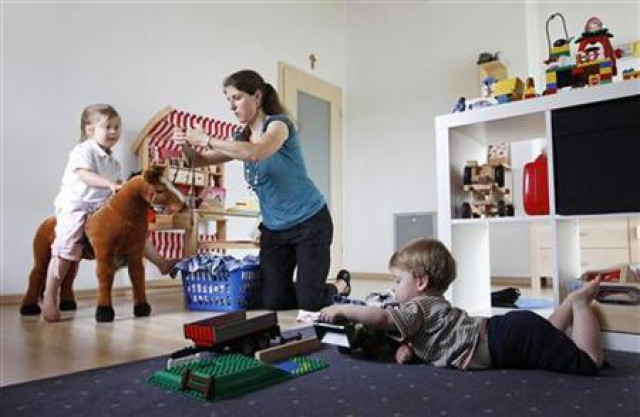Baby on board: Is your house safe for tumbling toddlers?
Of the 566 children in Karachi taken for treatment to emergency departments, 409 were injured at home, says study.

Pick up any parenting tome and it’ll have a section on child proofing a house. These include locks for drawers and cupboards, covers for power outlets and safety gates for stairs and keeping all sharp objects, medicines and cleaning products out of a curious child’s reach.
Despite Pakistan’s population rate, there appears to be no education on child proofing - both in urban and rural areas - or any accessible, inexpensive tools to do so. Parents who do childproof their house rely on DIY measures such as stringing rope around banisters to avoid children falling through the gap, taping up sockets and rearranging the furniture.
However, children have a free run at in most homes, with no bars on them poking into cupboards, standing near the stove or close to furniture with sharp corners. Parents admonishing their children to be careful are often told by elders to “let the kids play”.
It isn’t a surprise then that the highest number of injuries in children recorded at four public hospitals in Karachi occurred at home, according to research by a four-member team from the Department of Emergency Medicine at the Aga Khan University and experts at the Department of International Health and International Injury Research Unit at the John Hopkins University’s Bloomberg School of Public Health. The study was published January 19, 2012 in BMC Research Notes as ‘Understanding unintentional childhood home injuries: pilot surveillance data from Karachi, Pakistan’. Of the 566 children surveyed for the study who had been taken for treatment to emergency departments, 409 were injured at home. Twenty percent were injured on the roads and 11 per cent had suffered dog bites. The majority of injuries took place during playtime.
The research also documents 37 cases of burns - the most common cause was contact with hot liquids.
The need for child proofing a house is underscored by how 240 of the children surveyed were injured as a result of falls. Sixty-nine children took a hit on the stairs, including those inside the house, 25 fell from the bed and 19 from playground equipment. Over a hundred children fell from other heights such as off walls or balconies.
The data concurs with a 2010 study that focused on 2,292 children in Mastung in Balochistan and Tando Jam in Sindh. It also found that the most predominant cause of childhood injuries was falls.
In the former study, there were seven reported cases of poisoning: from ingesting medicines, chemicals, kerosene and spirit. Another issue of child safety at home is highlighted here: the poisonous materials were kept in bottles not marked or intended for the purpose. While medication available abroad comes with tricky childproof bottles, in Pakistan medication is available in packaging that is easy to open.
Dog bites are also a cause of concern. Of the 44 cases of dog bites, 19 were bitten by a dog while playing. The issue largely emanates from the prevalence of stray dogs in Karachi, and one that the government has only usually attempted to counter with poisoning stray dogs - a strategy deemed largely ineffective - instead of neutering them.
The researchers analysed that like in previous studies, male children represented a higher proportion of those injured. But they also note that while this was usually attributed to ‘higher risk-taking behaviour in boys compared to girls’, in the study’s context it might point to cultural issues such as allowing boys more independence at an early age and the tendency to take boys to the hospital while opting to get injured girls medical treatment at home.
The authors also note that caretakers reported a very small percentage using measures to prevent children access to hot liquids and hazardous medication and material, or using age-appropriate car belts and seat belts.
Policy Issues
The authors look at key policy issues in the study as well, summarising them as:
1. A need to follow standards for constructing houses. There is a lack of safety gates or grillers for stairs. Additionally, multi-level houses increase the risk of falls
2. The local government needs to take measures to control the stray dog population
3. Traffic calming and speed reducing measures need to be enforced in residential areas and around parks and playgrounds
Published in The Express Tribune, September 11th, 2012.



















COMMENTS
Comments are moderated and generally will be posted if they are on-topic and not abusive.
For more information, please see our Comments FAQ